Record of Program in 2011/2012
Program status Participants life
Participants in 2011/2012
| Country | Organization | Age | Sex | Rank, title, etc |
|---|---|---|---|---|
| Indonesia | Indonesia Maritime Security Coordinating Board |
26 | Male | National Law Coordination Bureau, Maritime Second Lieutenant |
| Directorate General of Sea Transportation |
29 | Male | Port Administration Office, (Ensign) | |
| Indonesia Marine Police | 26 | Male | Patrol Boat Officer, (Sub-Lieutenant) | |
| Malaysia | Malaysian Maritime Enforcement Agency |
30 | Male | Commanding Officer, Lieutenant Maritime |
| Marine Operation Force | 32 | Male | Internal Security and Public Order Department, (Lieutenant) | |
| Philippines | Philippines Coast Guard | 29 | Female | Flag Lieutenant for Admiral, Ensign |
| 32 | Male | Search and Rescue Vessel Officer, Lieutenant Junior Grade | ||
| Japan | Japan Coast Guard | 25 | Male | 2nd Officer of Patrol Vessel (Ensign) |
| 25 | Female | 2nd Officer of Patrol Vessel (Ensign) |
The program status in 2011/2012
| Date | Activity |
|---|---|
| April 18 | |
| May 9 | |
| May 26 | |
| June | |
| July 27 | |
| August 21 | |
| September 13 | |
| October ~ November | |
| December 17 | |
| February 20 | |
| March 7 | |
| March 9 |
April 18, 2011 Participants arrived in Japan
The first group of seven participants (three from Indonesia, two from Malaysia and two from the Philippines) arrived in Japan and started orientation from April 19 at the Hiroshima International Plaza.
Participants arriving at Hiroshima International Plaza |
Participants introducing themselves |
Welcome speech of training advisor |
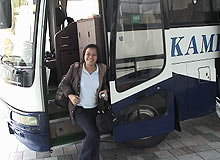 |
 |
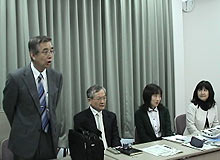 |
Enjoying a meal at the Hiroshima International Plaza |
Sharing times with Japanese participants |
Inputting information on PCs at the HIP |
 |
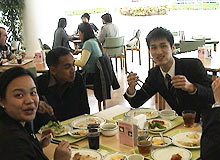 |
 |
May 9, 2011 Opening ceremony was held. The training started
A memorable opening ceremony for the 1st Asia Coast Guard Junior Officer Course of Japan was held in the presence of Mr. Kazutoshi KOMURA, Kure City mayor, and Mr. Kiyoshi HARA, Chairperson of the Steering Committee and former President of Kobe University of Mercantile Marine. Mr. Haruhiko URYU, the superintendent of the Japan Coast Guard Academy, appointed the participants. Mr. Kenichi UCHINAMI, Director General of the Administration Department JCG and others made a speech. Mr. Tridea SULAKSANA, Indonesia Maritime Security Coordinating Board, made a pledge.
Pledge by participant |
Participants with serious faces |
Speech of DG, Administration Dept.,JCG |
Speech of the superintendent of JCG Academy |
 |
 |
 |
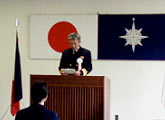 |
Speech of Kure City mayor |
Speech of President, JCG Association |
Introduction of Chair of the Steering Committee |
Media interviewing participant |
 |
 |
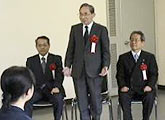 |
 |
After the ceremony the participants attended another ceremony for departure of the training ship KOJIMA for her around-the-world voyage. One of the participants made a comment that it is lucky for those trainees of the Academy to experience the ocean voyage in the world by such a fine training ship.
A welcome party was held in the evening. The participants had a good time with JCG Academy staff and some students.
Participants sending off the training ship |
Departure of the training ship KOJIMA |
Nice view of the Seto Inland Sea from Academy |
Participant talking with students |
 |
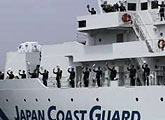 |
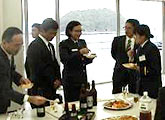 |
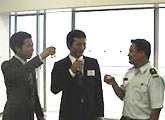 |
Participants introducing themselves |
Very nice atmosphere at the party |
 |
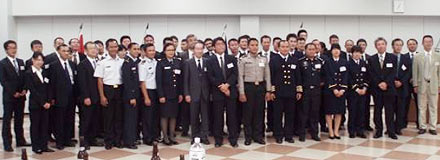 |
On the next day of the opening ceremony the training started. The participants presented their country report and gained an understanding of the situation of each country.
Participant explaining his country |
A lot of questions coming from the floor |
Two of them presenting collaboratively |
Japanese participant presenting in English, too |
 |
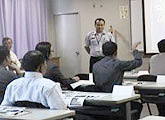 |
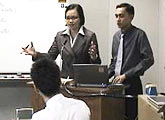 |
 |
May 26, 2011 A joint press release by the Nippon Foundation and the Japan Coast Guard
A joint press release about the implementation of the Asia Coast Guard Junior Officer Course of Japan was issued at the Nippon Foundation in Tokyo on May 26.
Admiral Suzuki, Commandant of the Japan Coast Guard, remarked that the Japan Coast Guard implements the training course based on the strong needs and request from coast guard agencies of the Asian region. He also mentioned that this course aims to strengthen their support and cooperative relations, and to develop the human resources of the Japan Coast Guard and to further enhance globalization of the Japan Coast Guard.
Mr. Sasakawa, chairman of the Nippon Foundation, mentioned that the foundation had sponsored and organized Tohoku region disaster reconstruction assistance activities by student volunteers and that some Japan Coast Guard Academy cadets had participated in these activities and had been highly appreciated by the local people. He hopes that the JCG Academy that gives education and training for these remarkable cadets will also help to foster human resources in coast guard agencies in the Asian region. The foundation expects that the Japan Coast Guard Academy will become the international base for human resources development of Asian coast guard agencies by accepting course participants from an increasing number of countries in the future. He also stated that the foundation would support for this.
On behalf of the participants, Ms. Noemie Guirao CAYABYAB, the Philippine Coast Guard made the following pledge:
"We will endeavor to gain extensive knowledge and deepen mutual understanding among the participants in order to develop good relationships.
We will also employ the acquired skills and ties among the participants to contribute to the development of our respective organizations and to try to build cooperative relationships among coast guard agencies in our countries upon completion of the training. We pledge to do our best for the sake of safety and environmental conservation in Asian waters."
Pledge by participant |
Commemorative photo with Chairman and Commandant |
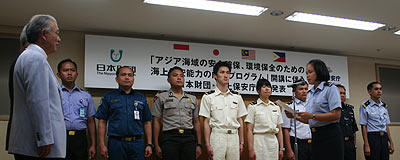 |
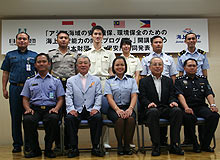 |
June 6, 2011 Visit to the 3rd Regional Coast Guard Headquarters and Yokohama Maritime Disaster Prevention Base
The training by the Japan Coast Guard, Tokyo, started on May 27. As a part of it, the participants visited the 3rd Regional Coast Guard Headquarters and Yokohama Maritime Disaster Prevention Base on June 6. At the Command Operation Center of the 3rd Regional Headquarters, they received an explanation about the function of Rescue Coordination Center, RCC, and observed the operation of Japan Coast Guard 118 Emergency Call. They also observed how the images taken from a helicopter were transmitted by the system. With this system the images taken from a helicopter were clearly displayed on a monitor set at the Disaster Prevention Base.
observe the images transmitted from a helicopter |
||||
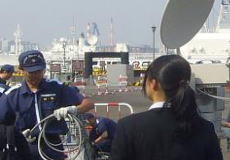 |
 |
 |
||
June 23, 2011 Work up a sweat by practicing the arresting technique
The participants change their uniforms for martial arts ones to practice the arresting technique.
The Asia Coast Guard Junior Officer Course of Japan includes lessons in arresting technique by the Japan Coast Guard. It helps to enhance their skills in apprehending suspected criminals, to maintain their strength and to relieve stress. It also provides good opportunities for interaction with instructors and cadets.
The Japan Coast Guard has dispatched experts to the coast guard agencies of Indonesia, Malaysia and the Philippines, respectively, and has given them training in arresting technique.
practicing the arresting technique |
||
 |
 |
 |
June 28, 2011 Participants joined the international exchange program
The international exchange program including the cadets’ conference was held from June 28 to July 4 at the Japan Coast Guard Academy (JCGA). We invited six cadets from the United States Coast Guard Academy, the Canadian Coast Guard College and the Korea Maritime University (one male and one female cadet from each).We also invited Asia Coast Guard Junior Officer Course of Japan (AJOC) participants to the program. At the cadets’ conference, they attended presentations about the systems of education and training for coast guard missions and cultures of each country. They actively exchanged opinions based on their work experience with other participants. AJOC participants also joined other programs such as the study tour to the Kure Coast Guard Office and the JCGA’s facilities, cruising on patrol craft, a special lecture, experiences of Japanese culture and a welcome reception with the invited overseas cadets.
the cadets’ conference |
study tour of the Kure Coast Guard Office |
experience of Japanese culture |
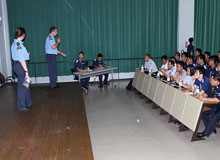 |
 |
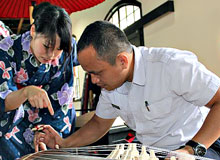 |
July 8, 2011 Sailing with Sea Princess
On 08 July 2011, gentle sea breeze, warm July summer sun and calm Seto Inland Sea waves greeted the AJOC participants as they embarked on the Sea Princess, a JCGA owned sail boat, marking another first experience for most of the participants. Sailing in a sailboat is considered a rich man sports in most of the participants’ countries not like in Japan where pleasure sailing is part of their culture.
Sea Princess, a 12 meter vessel, was a thing of beauty and truly rightful to her name. A princess in her own right, the sailboat gently cuts through the waves as members of the JCGA Yacht Club steers her jib and main sail to the most appropriate angle so as to catch the maximum strength of the wind needed to propel her.
It was an exhilarating and educational experience for all the participants as riding and sailing on a real sailboat proved to be trickier than it looks, specially going upwind. Much to our amazement, we realized that there is a lot of physics involved in sailing, much like flying an airplane.
At the end of the 30 minute ride, the participants had a deepened appreciation on how to utilize and tap the forces of nature to work in favor of a seaman. And as the Princess let down her sail, the AJOC participants bid her not “Sayonara” hoping that a day will come when we will ride her again.
sail training on Seto Inland Sea |
participants on board Sea Princess |
setting the sail |
 |
 |
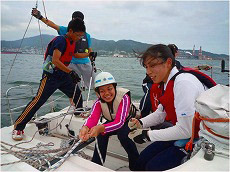 |
July 15, 2011 Participants tried initial investigation training
As part of practical basic subjects, training in initial investigation was given by a lecturer from the Criminal Affairs Division of the JCG Headquarters in Tokyo, and by some crew of a patrol vessel of a designated ship for identification, from Hiroshima Coast Guard Office. The participants learned the significance and purpose of initial investigation and precautions in the lecture the previous day. Despite the summer heat, they tenaciously practiced preservation of the scene, basic photography, bloodstains collection and questioning. The mock crime scene was well prepared and there was heated interaction with the suspect and the witness. They could get the gist of initial investigation.
fingerprints collection training |
preservation of evidence at the crime scene |
collection of evidence at the crime scene |
 |
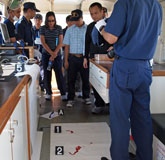 |
 |
July 27 to 29, 2011 Participants went to Kagoshima on their field trip
The participants took the newly inaugurated Kyushu Shinkansen, or bullet train, to Kagoshima. They visited the 10th Regional Coast Guard Headquarters,
Kiire oil storage station and Sendai nuclear power plant.
At the 10th Regional Coast Guard Headquarters, the Commander gave a lecture on leadership and the Deputy Director of Guard and Rescue Department explained regional
characteristics of their mission such as measures for remote islands. They drew on their abundant experience and the participants asked many questions later.
Lecture by Commander |
Lecture by Commander |
Lecture by Deputy Director |
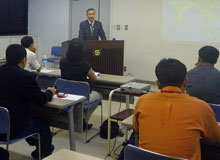 |
 |
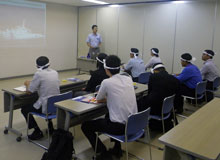 |
| Participants wearing headbands, or Hachimaki, as a symbol of teamwork |
At the Kiire oil storage station, they observed huge tanks, a VLCC on the berth and state-of-the-art disaster prevention equipment and they also received
a detailed explanation about exhaust gas treatment as an environmental measure.
During their visit, they could see volcanic fumes coming from Mt. Sakurajima far in the distance. The staff of the station said “It welcomes you,” and they were
delighted by that.
Briefing on the station |
Explanation of foam fire-extinguishing system |
Mt. Sakurajima welcoming them |
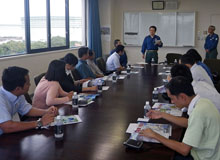 |
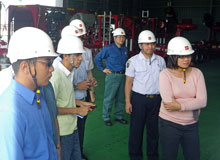 |
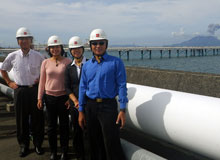 |
At the Sendai nuclear power plant, they observed mock-ups of pellets and reactor cores in the exhibition pavilion that they have learnt about at the Japan Coast Guard Academy. They could look around behind the scenes of the plant and get a better understanding of nuclear energy.
Briefing on nuclear power plant |
Explanation using mock-ups |
 |
 |
The participants were invited to a reception sponsored by the 10th Regional Coast Guard Headquarters and warmly welcomed. They danced together and had a very good time
Welcome reception |
welcome reception |
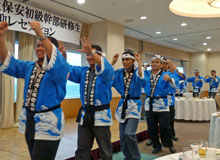 |
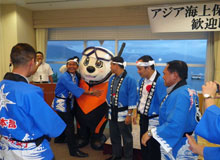 |
August 21 to 25, 2011 Participants went to Okinawa on their field trip
During their stay in Okinawa, the weather was nice and the scorching sunlight reminded them of their home countries. The participants visited the 11th
Regional Coast Guard Headquarters, Naha Air Station and Nakagusuku Coast Guard Office.
At the Regional Headquarters, Commander delivered a welcome address and the representative of participants extended their gratitude. Then they exchanged their business
cards and the day began in a friendly atmosphere. Director for Planning and Coordination on Guard and Rescue explained regional characteristics of their mission
including guard of territorial waters, illegal immigration and smugglings, and leisure accident response. The participants were quite curious about the countermeasures.
Courtesy call on Commander |
Exchanging business cards |
Lecture by Director |
 |
 |
 |
At the Naha Air Station, in the morning, the participants had a briefing on its activities and observed trainings of mobile rescue technicians and aircrafts in the hangar. In the afternoon, they boarded on Bombardier with JICA training participants to experience a patrol including the oil spill response drill. They were amused by a beautiful sea of Okinawa, too.
Briefing on Naha Air Station |
Descending training |
Boarding on Bombardier |
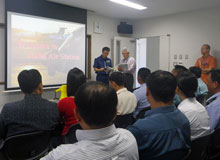 |
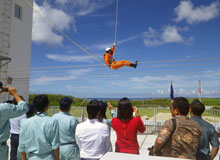 |
 |
At the Nakagusuku Coast Guard Office, Chief himself gave a briefing. The participants experienced arresting training, observed high speed patrol craft, and boarded on a high speed rubber raft. They were eager to ask many questions to the commanding officer and crew who are active in the front lines.
Training in arresting technique |
Observation of a high speed patrol craft |
Boarding a high speed boat |
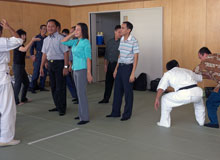 |
 |
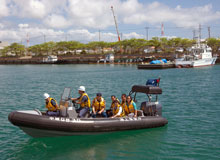 |
Under the full support of the Regional Headquarters, the participants learned a lot. What impressed them most was the interaction with the Japan Coast Guard
staff with their warm hospitality.
They also visited Global Oceanographic Date Center (GODAC), Churaumi aquarium, Shurijo castle park, and Okinawa world. The trip helped them extend their
knowledge on the ocean and unique culture of Okinawa.
Observing water pressure experiment (GODAC) |
At Shurijo castle park |
At Okinawa world |
 |
 |
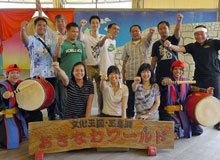 |
August 21 to 25, 2011 Training Program in Okinawa (observation tour)
Who is in this world never heard about Okinawa? If never heard of it, you should learn a lot about it. It is one of the most attracting places in Japan
(at least for myself). Okinawa has comfortable weather and it is the only prefecture in Japan located in the subtropical zone. On a world map, Okinawa is just a small
dot in the Pacific Ocean, but it used to be an independent kingdom, the Kingdom of Ryukyu.
Nowadays as part of Japan, Okinawa has developed its own unique history and culture. Okinawa has to maintain all “treasure” (shimanchunu takara) inside this
island. To maintain safety, security and marine environment is the priorities of the Japan Coast Guard 11th Region. In the East coast, vicinity of Nakagusuku bay,
Nakagusuku Coast Guard Office is ready to serve the nation. Supported by Naha Air Base Station headed by chief, the air station is ready 24 hours to serve the nation as
well as guarding terrritorial seas and internal water, saving lives and marine protection. Please feel safe and secure if you have interest to come.
Visiting Okinawa Churaumi Aquarium is one of the most interesting observation and recretional activities. The large acrylic window through which this “super impressive”
scene is displayed is 8x22x0.6 meters (can you imagine?). A kaleidoscopic vareity of fish swim in the large tank. There are a giant whale shark 8.5 meters in lenght
and many manta rays which are the world’s record for longevity in captivity. For culture experiences we visited the Shurijo Castle Park and “The Culture Kingdom
Gyokusendo” Okinawa World (near the Valley of Gangala). Eisa dance attraction is performed here and this dance is traditionally performed during Obon in Okinawa and
if you are not powerful enough, you can not perform the real music (sure for it). In this place 450 tropical trees are cultivated including fruits tree such as papaya,
banana, mango and many kinds of rare seasonal flowers. The attraction of snake and mongoose race show is also performed here. The most marvelous thing is Gyokusendo
Cave, the amazing “natural museum” beatifully carved over 300,000 years.
Nago city is a very famous city in Okinawa and it hosted the G-8 summit in 2000. The Global Oceanographic DAta Center (GODAC) was established here to attract
information-related companies to the Northern Districts of Okinawa. GODAC is managed by Japan Agency for Marine-Earth Science and Technology (JAMSTEC). Digitalized and
archived deep-sea images and academic papers are available to the public through the internet and they can be accessed by anybody.
Every participant of this observation tour enjoyed the field trip and all targets were reached. The Commander, officers, staffs of the 11th Regional Office welcomed
us and taught us so well. Who knows we will meet again some day? If we assemble again, I’m sure that we will have a good time singing a song of Okinawa with lots of
Awamori.
...Itsu no hika kono shima o hanareteku sono hi made, taisetsu na mono motto fukaku shite itai. Sore ga shimanchunu takara.
Boarding to the Bombardier Q 300 |
Boarding to a patrol ship |
Experiment in GODAC |
 |
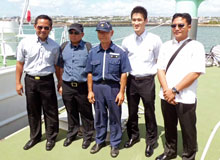 |
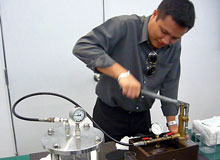 |
September 13 to 16, 2011 Kansai District Study Trip
From September 13th to16th the AJOC participants went to the Kansai District for a study trip for the purpose
of observing the Coast Guard facilities in this area and visiting Kobe University. Osaka Bay is one of the most congested
sea areas in all of Japan. In this area, we were able to learn not only about the Japan Coast Guard but also about
Japanese maritime education.
With regard to the Coast Guard facilities, we knew how the Coast Guard was responsible for monitoring this large area.
Kansai Airport Coast Guard Station is a unique facility in Japan. In order to conduct effective patrol and to crack down
on illegal fishing in this area, it combines Coast Guard station and Air station. By knowing the advantages and
disadvantages of each duty area, they have established these facilities in order to compensate for each other.
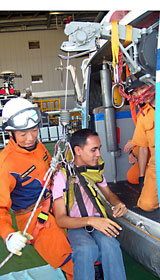 |
Rescue skill experience |
Through this trip, I was able to expand my knowledge on maritime issues as a whole. The sea is large and expansive, affecting many people. Not only AJOC but also many people around the world are studying and researching various important maritime issues around the world, and all issues are interrelated. This means we are also playing an important role for maritime safety and development.
Exchange arrangement at Kobe University |
Participants with training ship "FUKAEMARU" |
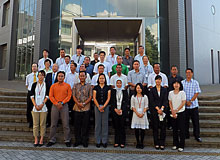 |
 |
September 13 to 16, 2011 Participants went to Kansai area on their field trip
In the middle of September, participants visited Kansai Airport Coast Guard Station, Kobe University Graduate School of Maritime Sciences and Japan Coast Guard School.
Kansai Airport Coast Guard Station has the function of both Coast Guard Station and Air Station. The participants, who had already visited Coast Guard Station and Air
Station, received an explanation of its unique duties and characteristics. They also observed the training of mobile rescue technicians and had an opportunity to try
the rescue equipment. Their knowledge of rescue issues was enhanced.
Lecture (Station Chief’s remarks) |
Trying on an air cylinder |
Experiencing being rescued |
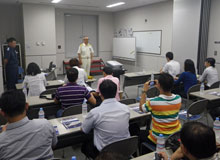 |
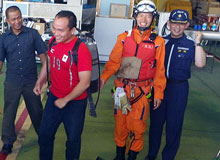 |
 |
In addition to broadening the view of maritime affairs, they visited Kobe University to interact with foreign students, who attend the graduate school from the Southeast Asian region. After the self-introduction, they had presentations, opinion exchanges, a facility observation tour and luncheon. They talked about their home countries and time passed so quickly.
Presentation of gift |
Presentations by the representatives |
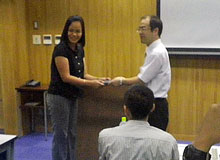 |
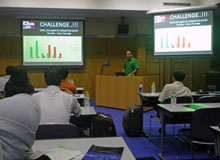 |
Their visit to the Coast Guard School started out with paying a courtesy call on Superintendent and Vice-superintendent. Education and training system is the biggest interest of the participants. The detailed explanation by the Superintendent was given and they asked many questions. During the facilities observation, they were impressed by how neatly students arrange their dormitory.
Courtesy visit to Superintendent |
Observation of students’ dormitory |
At the best view of the school |
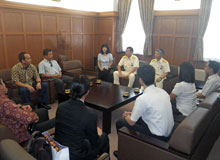 |
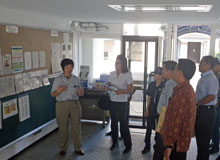 |
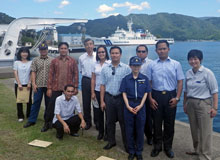 |
October 17 to 21, 2011 Training at Maritime Disaster Prevention Center (Yokosuka City)
From October 17 to 21, 2011, AJOC participants went to Yokosuka Training Center of Japan Maritime Disaster Prevention Center (JMDPC) to learn how to prevent disasters such
as fires occurring in the environment around us, especially onboard ship, and oil spills at sea. In this training, we were able to learn about prevention of maritime
disasters such as the tanker and LNG fires and oil pollution at sea. In relation to the importance of this training on maritime disaster prevention for the
coast Guard, we know how the Japan Coast Guard cooperates with the Japan Maritime Disaster Prevention Center to fulfill their responsibility in this large sea area.
Yokosuka Training Center of JMDPC in Yokosuka City is a unique facility in Japan. In order to prevent fires on ships and marine oil spills,
they trains and teaches staff. AJOC participants learned how to prevent disasters in the ocean, that is how to extinguish fires and clean up oil spills at sea.
Through this training, I could expand my knowledge about maritime disaster prevention. Not only the AJOC participants but also many people around the world are studying
and researching various important maritime issues, and all these problems are interlinked. This means that we also play an important role in maritime disaster prevention
and maritime safety.
After the Opening Ceremony at Yokoska Training Center of JMDPC |
Fire Fighting Training |
Oil Spill Cleanup Training |
 |
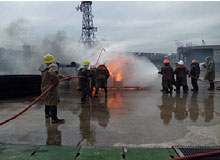 |
 |
October 17 to 21, 2011 Fire fighting and oil spill control training
The AJOC participants joined the one-week training course on fire fighting and oil spill control at the Maritime Disaster Prevention Center in Yokosuka. Lectures were given and included some experiments. The lecturer pointed out the important points for the final exam, which encouraged the participants. They learned the basics of fire extinguishment and the principles of combustion.
Photo after Opening ceremony |
Participants in uniforms |
Experiment in the lecture |
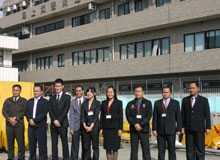 |
 |
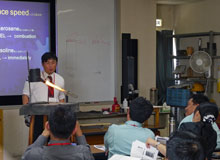 |
After the classroom lectures, they had exercises. There is a fire fighting practice site on an island in Tokyo bay where oil and gas fires are recreated. At this facility they could practice and refine their firefighting skills. On the day, the sea was not so calm, but they took a boat to the island. They wore fire-proof clothes, and cautions were repeatedly given. The ominous appearance of the facility made them nervous.
The sea was not calm |
The time has come |
The 1st step was initial fire suppression |
 |
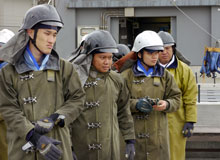 |
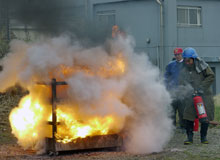 |
They observed various types of combustion and learned appropriate responses to them, including small scale fires, oil tank fires, fires in the engine room and fires in the cabin. At first, they went blank on fire extinguishment procedure when faced with a furiously burning fire. Gradually they were able to proceed at the word of command and to work as a team. At the end of the hard two-day exercise, they were able to make strategies by themselves and take command of fire suppression.
Fighting against huge fires |
With teeth-gritting effort |
By their own fire-fighting plan |
 |
 |
 |
After the fire fighting exercise they studied the removal of spilled oil and performed exercises with oil booms to prevent dispersion. The oil boom was a light type one, but it was still necessary to work together as a team to set it up. They also learned the importance of teamwork through this exercise.
They worked as a team |
Oil booms were set up |
Certificates were presented |
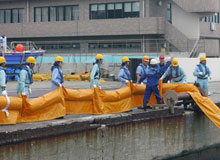 |
 |
 |
October 27, 2011 LNG Carrier Study Trip
AJOC participants had an opportunity to get on board a liquefied natural gas (LNG) carrier. An LNG carrier is a tank ship designed for transporting
liquefied natural gas. It has 4 spherical tanks. Her name is Umm Al Ashtan, flagship Liberia, gross tonnage 116,703, length overall 290.143 m, breadth 48 m, draught
12.3 m and she was built in 1997. She belongs to Abu Dhabi National Oil Company.
It was a sunny and fresh Thursday morning. Before we got on board the LNG carrier, we had to board tug boats. We were divided into two teams. The first team got
boarded the tug boat Sagami Maru, and the second team Hayama Maru. We were dispatched from Tokyo Bay Pilot Office Pier at 0910 hrs. After a 40-minute boat ride we
finally met her. LNG tank ships are designed with safety and security in mind. They must meet tough international standards. They are high-tech ships, using special
materials and design to safely handle the very cold LNG. Everyone involved in LNG transportation takes safety very seriously. There are many lives and a great deal of
money at stake. Government and industry work together to make sure these ships are designed, maintained, and manned with safety in mind; industry maintains them with
oversight by periodic government inspection, and government sets the standards for crew training. This has resulted in an outstanding safety record. Over the last 30
years, there have been about 33,000 LNG voyages worldwide, and none of them has there been a significant LNG spill. Currently, there are approximately 180 LNG ships with
about 110 more being built. They were so well designed that, even when a submarine surfaced directly under an LNG ship, there was no damage to the LNG tanks, though
there was damage to the tank ship's bottom.
We had to climb the gangway from the tug boat to board Umm Al Ashtan. It was very high. If you are afraid of heights, don’t worry, safety measures are taken. On board
the deck, we met the chief officer, Mr. Davis. He was very friendly. After that we were brought to the conference room. We were briefed by him regarding his job, the
LNG carrier specifications and its operation. After a short briefing, we went to the bridge. Finally we met the captain of the LNG carrier. He was a tall man with a
big smile. We talked with some officers on the bridge. They were very keen to talk and answer our questions even though they were busy.
Thanks to them we learned a lot. The LNG carrier has emergency shutdown systems that can identify potential safety problems and shut down operations. This significantly
limits the amount of LNG that could be released. Fire and gas detection and fire fighting systems help address the risk of fire. Special operating procedures, training,
and maintenance further contribute to safety. LNG vessels also have equipment to make ship handling safer. This equipment includes sophisticated radar and positioning
systems that enable the crew to monitor the ship's position, traffic, and identify external hazards. A global maritime distress system automatically transmits signals if
an onboard emergency occurs that requires external assistance. In addition, some LNG ships use velocity meters to ensure safe speeds when berthing. When moored,
automatic line monitoring helps keep ships secure. When connected to the onshore system, the instrument systems and the shore-ship LNG transfer system act as one,
allowing emergency shutdowns of the entire system both from ship and from shore.
As she was en route to the Uraga Suido (Uraga channel) and Naka-No-Se, we could see the MARTIS (Maritime Traffic Information Service), or Traffic Advisory Information
Service Center, building, whose mission is to maintain and improve safety and efficiency of vessel traffic in the Tokyo Bay. It was established and is operated by Japan
Coast Guard. Tokyo MARTIS is operated in accordance with acts, cabinet orders, ministerial ordinance, public notices and administrative guidance. Tokyo MARTIS maintains
and improves vessel traffic safety of the Tokyo Bay by collecting, verifying and monitoring vessel traffic information by sensors such as Radio Detection and Ranging
(RADAR*), Intelligent Transport System (ITS), Automatic Identification System (AIS) and VHF radiotelephone. It also provides information necessary for the safety of
vessels, navigational advice to vessels when considered necessary to avoid imminent danger or the possibility of the violation of traffic rules, and instructs vessels to
stand by outside the traffic routes if visibility is restricted. It gives permissions or arranges the time of entry into the traffic route. In addition to VHF
radiotelephone communication, Tokyo MARTIS provides navigational assistance information by radio broadcast, telephone, fax and Internet homepage.
Finally at 1220 hrs she berthed at LNG terminal Futtsu Thermal Power Plant. After that Mr. Davis invited us to have lunch on the LNG carrier. The food was marvelous.
We finished our study tour at 1300hrs. We were very grateful for the hospitality of the captain and his crew. I found this study trip to be very exciting and educational
for us.
*An object-detection system which uses radio waves to determine the range, altitude, direction, or speed of objects
Boarding LNG carrier |
Four spherical tanks |
Panoramic view |
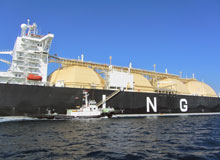 |
 |
 |
October 17 to November 7, 2011 Tokyo district study trip
The Tokyo district study trip lasted more than three weeks and included firefighting and oil spill response training at the Maritime Disaster Prevention Center (MDPC) in Yokosuka. After the tough training at the MDPC, AJOC participants received various additional training in Yokohama and Tokyo.
Looking at the control board |
Various oil adsorbent |
Listening to the explanation about the spy ship |
 |
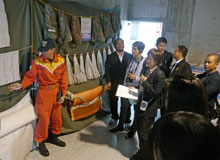 |
 |
In Yokohama, they visited the Tokyo Traffic Advisory Service Center (Tokyo MARTIS) and Yokohama National Strike Team Station to learn about maritime safety and security operations. They also visited the JCG Museum Yokohama to find out about the North Korean spy ship case. They had opportunities to board a patrol ship of the JCG and a large-scale LNG tanker in the Uraga Suido (Uraga channel) route so that they could experience the actual situation and safety measures of maritime transport in the congested Tokyo Bay. When they transferred from a small tug boat to the large tanker, the weather was a concern. Fortunately it was fine and the sea was calm. The experience of boarding the ships for different purposes helped broaden their perspectives and deepen their understanding about maritime traffic service provided by the JCG.
Carefully transferring to LNG tanker |
The steering room was so wide |
The view was so broad |
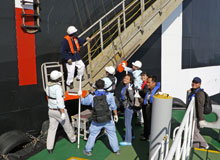 |
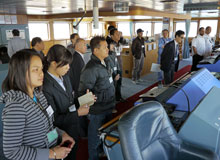 |
 |
In Tokyo, they had lectures about maritime safety and security operations including international organized crime at the JCG Headquarters. They visited the Coast
Guard Research Center in Tachikawa and Haneda Air Station. They made good use of the time there.
At the Research Center various training topics were prepared. One was the process of identifying a ship by analyzing the layers of paint from a scratch mark.
Identification of drugs, counterfeit bills and passports was explained using the operation of equipment. Some participants looked into the sample under the microscope.
Through this visit, they came to appreciate the importance of scientific investigation.
The Center was originally a lens factory |
Looking at fragments of paint |
Real or fake? |
 |
 |
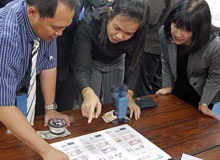 |
When they visited the Haneda Air Station and Special Rescue Station, there were many questions about the coordination of rescue operations. They found that indispensable equipment for the possible cases was always well prepared and the team was at full readiness.
At the airplane hangar |
Explanation of descending apparatus |
Demonstration by paramedics |
 |
 |
 |
They visited a maritime consulting company and a container terminal in order to gain extensive knowledge about maritime safety operation. They received explanations about consulting services related to both domestic and overseas maritime traffic safety and were able to obtain information and knowledge with container transportation in situ.
Observation of simulator |
At the container terminal |
Briefing by the captain |
 |
 |
 |
One of the purposes of the study trip was to interact with the JCG staff so as to enhance mutual understanding. On November 2nd they had an informal get-together with the attendance of Mr.Uchinami, Director of the Administration Department and other 50 JCG staff. Two participants had birthday in November, so cakes were kindly prepared for them. They had a great time.
Memorial group photo |
Happy Birthday |
 |
 |
December 17 to 20, 2011 Shipboard Training Onboard “PL 21 KOJIMA”
The AJOC participants joined the three (3) days shipboard training with Japan Coast Guard Academy (JCGA) 4th Grade Navigation and Engineering cadets’ onboard Japan Coast Guard (JCG) training ship “PL 21 KOJIMA” from December 17 to 20, 2011. The 3-day navigation route started from JCGA wharf in Kure to Beppu Point on the island of Kyushu.
The onboard training experience was designed in able for the participants to observe and learn how the JCGA cadets are trained onboard, to understand the daily task of the patrol vessel and the contents of training cruise, to observe the training and navigational exercise by the KOJIMA’s crew and cadets, and to learn the command capability for emergency at sea such as ship distress and the operational ability for patrol vessel.
During the shipboard training, participants received lectures from the officers of KOJIMA, observation in engine and communication rooms; observe the cadets’ training/ exercises during departure and arrival at the port, towing and navigation watch (day and night). The participants were also able to experience cadets’ life by joining cadet’s calisthenics, preparing and joining in the mess, and observing KOJIMA’s training schedule which includes the cleaning time, shower time and the 2030H shipboard inspection. Furthermore, the participants enjoyed the first class varieties of meal served in KOJIMA.
In front of KOJIMA |
Observing the exercise |
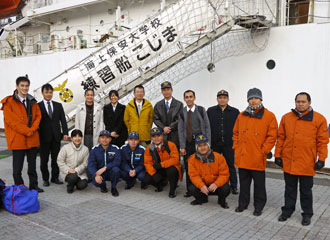 |
 |
As the shipboard training concluded, the participants are expected to acquire depth understanding on JCGA’s onboard education and training system and to determine areas which can be of help for the improvement of their organization’s shipboard education system. Moreover, the said training is also a good avenue for the participants, cadets and KOJIMA’s officers and crew to build good relationship, as well as strengthening professional partnership and cooperation between the four (4) participating countries.
At the ceremony |
“All on deck” |
 |
 |
December 17 to 20, 2011 KOJIMA THE INTERNATIONAL CLASS TRAINING SHIP
Applying knowledge on board the ship is one of the most important programs for each maritime-related institution. Kojima is one of the training ships owned by Japan Coast Guard (JCG) which was commissioned on 11 March 1993. Kojima’s gross tonnage is 3,136 and she is the 4th generation ship with dimensions: 115m x 14m x 7.3m and capacity of 58 crews and 60 cadets.
The AJOC members boarded from 17-21 December 2011 and we observed some duties and team work conducted by the commanding officer, officers, crews and cadets in Kojima. The AJOC members boarded Kojima with the 4th year cadets for inshore cruise around Honshu and Shikoku.
For AJOC members the objectives of this observation were to observe the cadet’s abilities to operate, coordinate and their team work abilities as JCG’s shipboard officers, observe comprehensive team duties between cadets and Kojima’s crew. In addition, having direct experience on board the ship was one of them if they were not familiar enough with onboard situation. Sailing in the Seto Inland Sea, Hayasui Seto and the Bungo Channel by Kojima was a “flash back” memory for me. A few years ago I used to pass this channel many times. I got my first experience for navigation in narrow strait through this area in 2000.
Kojima sailed on 18 December from JCGA berth at 09.00 Hrs, with her bridge crews and cadets standby in their own post. Bridge resource management started. The command system during ship’s operation was almost same between on the bridge and on the scene (un-berthing process). The command was controlled on the bridge supported by ECR (Engine Control Room) and on the scene commander (fore and aft).
Towing preparation with rocket line |
Long and strong ropes used |
 |
 |
Preparation for towing |
Participants (with life jacket) watching the towing |
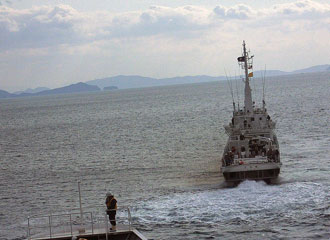 |
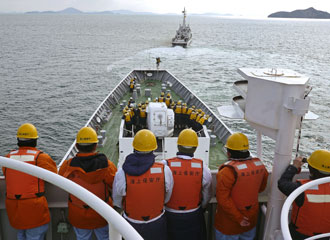 |
During the towing operation on-the-scene officer and crews had to move a lot and shall receive command from the bridge. The on-scene commander received information and delegated crews and cadets to monitor the scene. The on-scene commander had to watch the crew’s action.
During the engine room observation the author found the engine room was arranged safely, tidy and everything was put in their place and arranged very well. The author have so much experience to observe the engine rooms of foreign merchant ships and cruise ships in any kind of flag state as own duty as a Marine Inspector and Port State Control Officer in Indonesia, Kojima’s engine room was very clean compared with those vessels that ever observed. This was the tidiest and cleanest ship’s engine room in the world. This means the engine room management system, harmonization duty and coordination have been conducted well. As additional information related to engineer’s duties: Kojima’s air conditioner was very clean. The ship’s air conditioner is very important on board. Kojima has weather tight doors and windows and all the crew are attentive to close the doors tight due to safety and security, therefore air circulation on board especially in the cabin is produced by the air conditioner. The air conditioner was very clean and regularly cleaned, the chief engineer has explained with details and confidence. In the engine room during watch the engineers delegated some duties to cadets to check the machinery operation. In some occasions the engineers conduct emergency scenario in machinery space.
The AJOC members also observed Kojima’s radio room and received nice explanation by “The warm-hearted female officer.” Aside from daily training and observation, the participants also had a very good meals service on board the ship. Thanks to the staff who prepared meals, the meal service was unforgettable.
Engine control room observation |
AJOC members and training organizer |
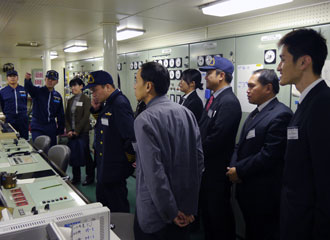 |
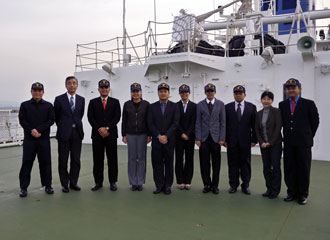 |
December 27, 2011 Special lectures by staff of the ReCAAP Information Sharing Centre
AJOC participants had special lectures by the invited staff of the ReCAAP Information Sharing Centre from Singapore on December 27, 2011.
ReCAAP (Regional Cooperation Agreement on Combating Piracy and Armed Robbery against Ships in Asia) is an agreement to promote regional cooperation in order to deal effectively with piracy and armed robbery in Asia. It was adopted in November 2004 and came into effect in September 2006. There are 17 contracting parties including Japan.
Based on this agreement ReCAAP ISC was established in November 2006 in Singapore. The roles of ReCAAP ISC include exchanging information among contracting parties on incidents of piracy and armed robbery, supporting capacity building efforts of contracting parties, and fostering cooperative arrangements.
Two lecturers were invited. One was an assistant director of programme division who was originally from the Japan Coast Guard. The other was a senior specialist (research) who is Singaporean.
The assistant director explained the overview and history of ReCAAP and the roles of ReCAAP ISC in detail. He described the information transfer process in the piracy and armed robbery cases. He also mentioned the importance of information sharing.
The senior specialist picked up some actual cases and explained patterns and trends of piracy and armed robbery. He emphasized the significance of information sharing among stakeholders to address the problems through the analysis of each and every case rather than quoting simple statistical figures.
There were opinions from the participants such as that for accurate and prompt information sharing, common recognition and cooperation among stakeholders are necessary. Therefore building a good relationship among them is first and foremost important. Challenges against piracy and armed robbery in the Asian region differ by country and by organization. Some countries have anti-piracy laws and some do not. It was a good opportunity for all of them to reconsider both the importance and difficulty of cooperation that leads to the region’s safety and security while respecting each country’s sovereignty.
Lecture explaining the overview |
Lecture introducing the analysis |
Participants in the class |
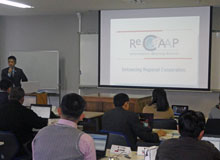 |
 |
 |
Memorial photo after the lecture |
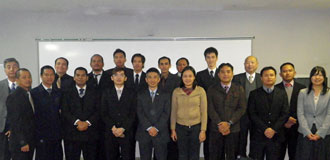 |
February 20 to 22, 2012 Trip to Monbetsu (Hokkaido)
On February 20th we departed from HIP for Mombetsu city in Hokaido by air. We had heard that there is a “Frozen City.” That information was correct, from the sky we could see frozen sea. When we arrived at Mombetsu airport, it was -6oC. It was like being in a refrigerator. For most of us this was the first experience to visit such a “White City.” It was very quiet and there were few people on the street. The streets were covered with snow and we could see white and thick snow on road side.
First in Monbetsu, we visited Mombetsu Coast Guard Office. We got a lecture of Mr. Arazeki, Chief of Monbetsu Coast Gurad Office, regarding the function and jurisdiction of Mombetsu Coast Guard Office. They work together with police and the customs to cope with illegal activities in their jurisdiction. They have unique jurisdiction where hot current and cold current meet making it rich in living creatures and that attracts poaching and illegal fishing in Mombetsu area.
Day second, we got a chance to experience sailing on the ice breaker (Garinko-go II) and sailed in the frozen sea. It was very cold and windy but very excited. We could take pictures and enjoy icing sea.
In this season usually they can see drifting ice, but unfortunately we couldn’t see them because that they were drifted away from the coast. Every winter that ice come to Mombetsu and become the famous attraction.
We attended the International Symposium regarding Okhotsk Sea and sea ice. This Symposium discussed the optimizing North Pole sea area in the business and the sailing method to minimize the cost of oil and the distance between Asia and Europe. These were new knowledge especially for me. Japan and European countries may develop Northern Sea Route after Russia opens their sea to use for commercial purpose as sea routes. They can predict the route which is observed by modern equipment and by image of satellite.
The last day we visited Okhotsk Sea Museum / GIZA. We got experience the true-to-life visuals of Astrovision, the audio-visual hemisphere, magnificent views of drift ice filmed from the sky, the coast line with a riot of flowers. Each season of the Okhotsk is spread over the entire dome, giving us 360 o visibilities.
The Museum gave us an opportunity to experience the severe coldness of -20oC. There was a botanical garden where the flowers of Okhotsk had been preserved in ice. There, visitors can experience and touch the real drift ice even in midsummer. Various sizes of fish and shellfish from the Sea of Okhotsk are preserved in ice from 1,6meter long sturgeon to tiny plankton.
in front of the CG office |
Lecture by Chief of CGO |
Visiting the museum |
 |
 |
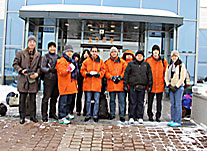 |
Icebreaker "Garinko" |
on board |
at the Symposium |
 |
 |
 |
March 7, 2012 The 1st Asia Coast Guard Junior Officer Course of Japan has been completed
The closing ceremony of the 1st Coast Guard Capacity Improvement Program to secure safety and environmental conservation in Asian oceans (Asia Coast Guard Junior Officer Course of Japan) was held at the Japan Coast Guard Academy in the presence of Dr. Hara, former provost of Kobe University of Mercantile Marine (Steering Committee Chairperson of the program.) Rear Admiral Uryu, Superintendent of the Academy, presented the certificate and gifts to the participants from Indonesia, Malaysia, the Philippines and Japan. Since the opening ceremony on May 9 in 2011, the training course has been done and dusted.
Rear Admiral Uryu |
Dr. Hara, former provost of |
Participants of AJOC |
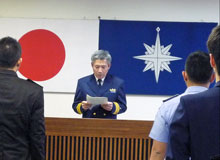 |
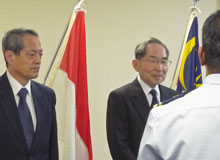 |
 |
present the certificate and gift |
||
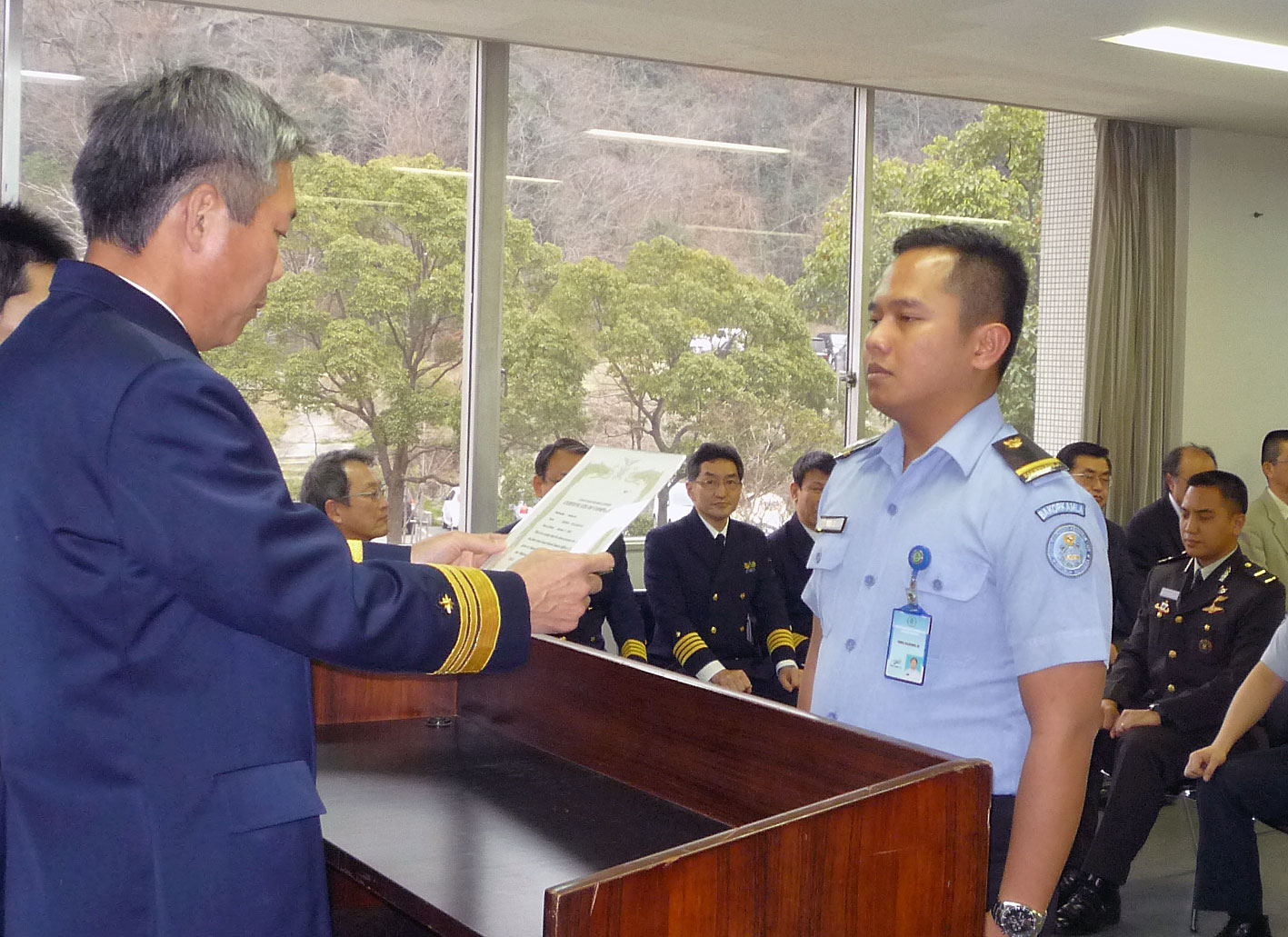 |
 |
 |
 |
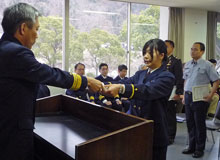 |
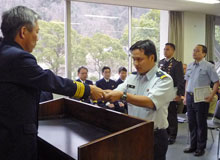 |
 |
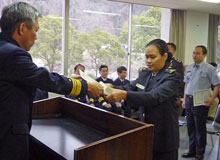 |
 |
end of the ceremony |
in front of the main building |
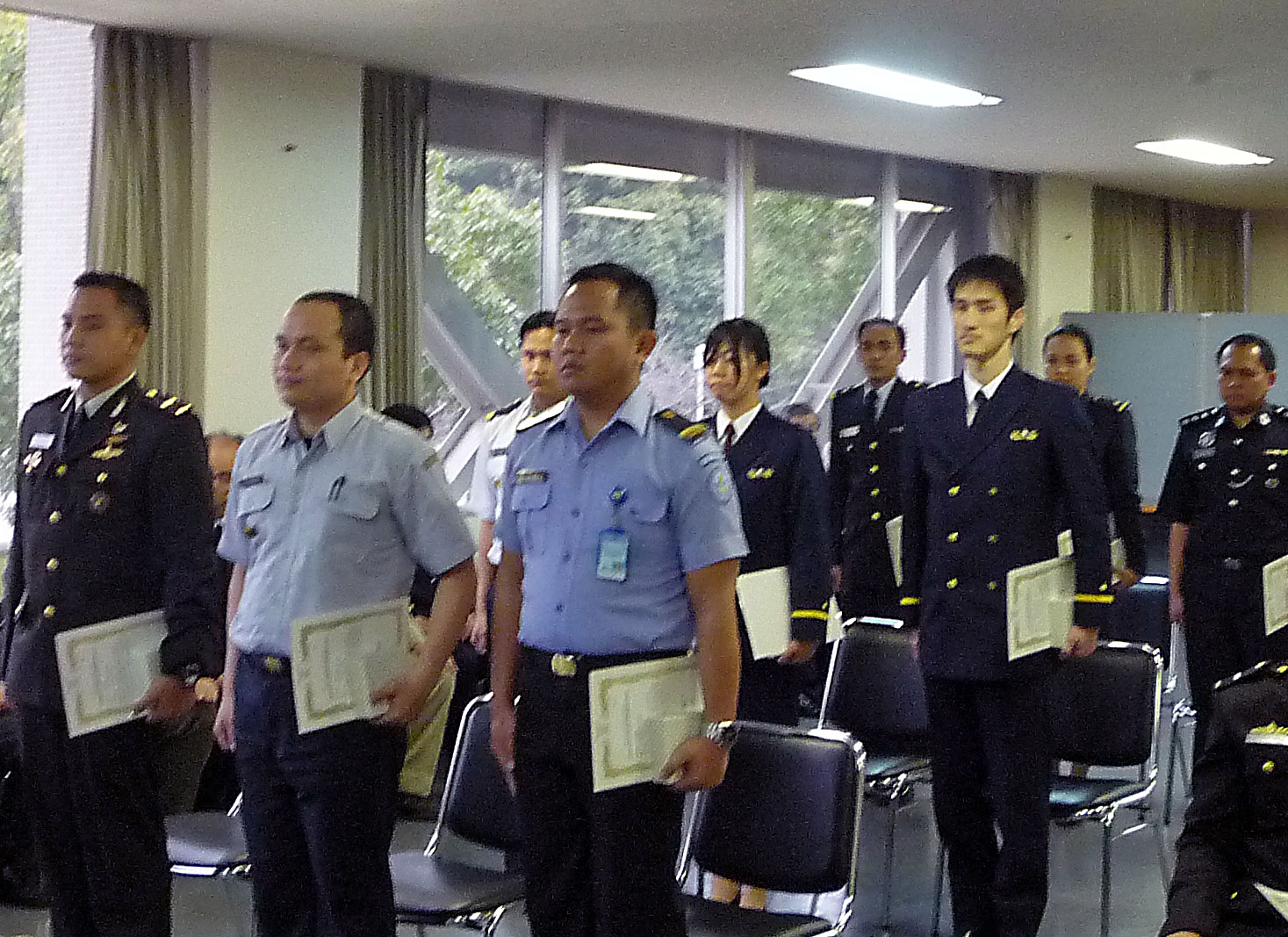 |
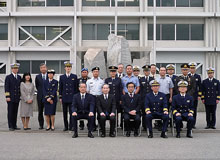 |
| This picture can be enlarged by clicking on it. |
After the closing ceremony, a farewell party was held. Prof. Michimoto, Vice Superintendent, delivered a speech and each participant also made a speech about the result and memories of their long training period.
Prof. Michimoto, vice superintendent |
||
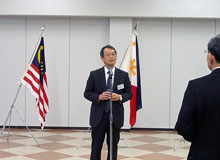 |
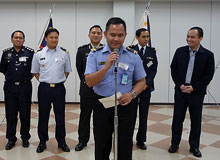 |
 |
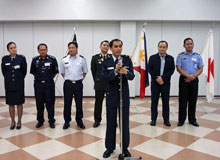 |
 |
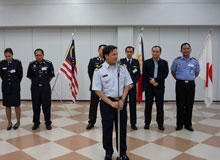 |
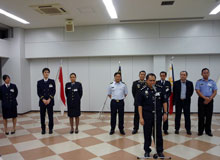 |
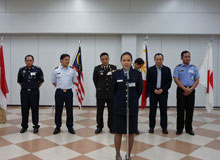 |
 |
 |
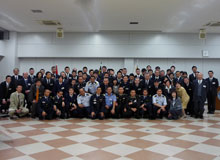 |
|
| This picture can be enlarged by clicking on it. |
The participants went to Tokyo. They visited the Japan Coast Guard headquarters and the Nippon Foundation to report the completion of the training. Then on March 10 the overseas participants departed from Narita airport for their respective countries.
March 9, 2012 Participants visited the Nippon Foundation to report the completion of the training
After the completion of the training, the nine participants of the Asia Coast Guard Junior Officer Course of Japan visited the Nippon Foundation to report their result to Mr.Unno, Executive Director of the Foundation. Each of them expressed his/her gratitude to the foundation for the support.
Mr. Unno mentioned that the participants showed their brilliant faces with confidence fulfilling the training. He also encouraged them to continue the relationship and to contribute to the happiness of people and the safety of society as leaders after returning to their respective countries.
Participants reporting their result |
Presenting a gift |
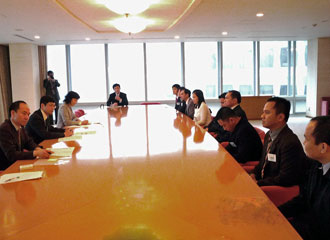 |
 |
Presenting a gift |
Participants with brilliant faces |
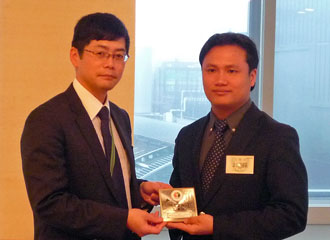 |
 |
| this picture can be enlarged by clicking on it |
Participants Life in 2011/2012
| Date | activity |
|---|---|
| May | |
| June | |
| July | |
| August | |
| August | |
| October | |
| November | |
| December | |
| January | |
| January | |
| January | |
| February | |
| March |
May 22, 2011 The participants joined the athletic meet at the nearby elementary school
There is an elementary school near HIP where the participants stay. At this school athletic meets are held to promote interaction with local residents. All nine participants joined the athletic meet to deepen exchange with the residents. They took part in the bun-snatching race, gate ball, relay races and other games. They enjoyed themselves very much.
A victory pose in front of pupils |
Participant carrying the baton |
A good time was had by all |
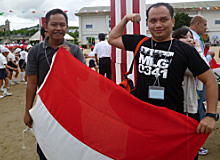 |
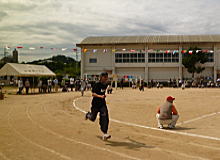 |
 |
June 25, 2011 Participants joined Miyajima Tour
The Asia Coast Guard Junior Officer Course of Japan (AJOC) participants joined the Miyajima tour together with other seven (7) countries’ JICA participants last June 25, 2011.
The tour is part of one of the primary objective of the course that is to provide the participants with general information concerning key points regarding Japan as well
as discovering Japanese culture and history.
The 1,400 years old Itsukushima (Strict Island) Shrine, the Miyajima’s greatest attraction and has been declared a national treasure by the government of Japan designated
as the UNESCO World Heritage Site, is one of the three (3) most scenic views the Japan has to offer.
The participants enjoyed taking photographs to the O-torii (shrine gate) which was built in 1874, the Gojunoto- which is five storied pagoda built in 1407, and the resident deer
that are always ready to take pictures. The participants were also able to experience hiking to the top of 535 meters elevated Mount Misen, the main peak of Miyajima covered
with picturesque old-growth forest by taking the Miyajima Ropeway, the aerial rope systems, circulating and funicular in series, which is rare and unique in Japan. The view
from the Mount Misen Summit was truly exceptional where we can see the magnificent landscapes and the great viewpoint of the Setouchi (Seto Inland Sea) dotted islands from
the Shishiiwa Observatory.
Indeed, it was a great enjoyable experienced for the participants to stroll through the nature and history of the island of the gods.
group picture at Shishiiwa Observatory |
O-torii(shrine gate) |
with deer |
 |
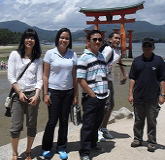 |
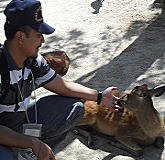 |
July 7, 2011 Japanese Class
We are very grateful for and enjoy the Japanese language class. The first lesson was an introduction: how to introduce ourselves in Japanese such as name,
occupation, country, home town, hobby etc. We tried to practice on the Japan Coast Guard Academy cadets. We also had outdoor activities to train our skills
at “surviving” in Japan, for instance, how to send a letter, how to ask in a store, how to ask the price, and how to ask directions etc.
In the class we not only study the language but also are introduced to Japanese culture.
We learned many interesting stories and sentences so that we can make a joke using some phrases, like “Oh…soro-soro shitsurei shimasu”
that means Oh…time is up or it is the time to say good bye, or “Ja, byoin ikimasyo.” Any time we hear somebody just say“Ja,”
we start thinking that he or she may say“Ja byoin ikimasyo”that means Ok, let’s go to hospital.
We have Japanese class every Friday for 2 hours from 19:00. Although we return to the Hiroshima International Plaza (HIP) from the Japan Coast Guard Academy
at around 18:00 and are sometimes a little bit tired, we are always eager to learn Japanese language, character, and culture.
Japanese Class in HIP |
Japanese traditional cloths |
 |
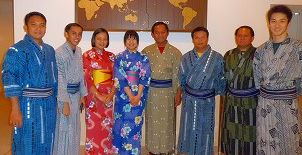 |
tea ceremony |
outdoor activity |
outdoor activity |
 |
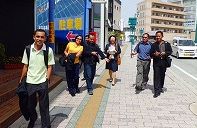 |
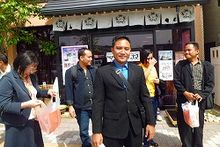 |
August 13, 2011 Participants joined the Bon Dance Festival
On 13 August 2011, AJOC participants joined the Saijo Bon Odori Taikai or Bon Dance Festival together with other participants from the JICA program. The festival was held in Mitate ground near Saijo bus station. This festival is celebrated by Japanese people every year on the 15th day of the seventh month of the lunar calendar and has been celebrated in Japan for more than 500 years and traditionally includes a dance, known as Bon Odori.All participants enjoyed the dance together with people from the surrounding community. This festival was a very good opportunity for us to get to know Japanese people more closely and learn about Japanese culture. Every participant seemed very excited to learn the art of the Bon Dance.
In addition to the Bon Dance event, we also appeared on stage of the Loud Shouting Contest. In this, contestants themselves were allowed to choose any Japanese words to shout. It was finally won by Harry-san and Richard-san from AJOC.
The festival ended with a colorful fireworks show.
They all enjoyed the dances |
Participants enjoying the Bon Dance |
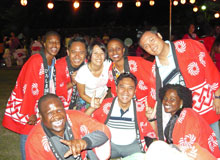 |
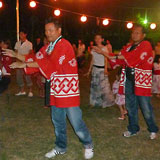 |
Contestant shouting Japanese words |
The winner received a prize of watermelons |
 |
 |
Fireworks at the end of the festival |
 |
August 19, 2011 Japanese Traditional Mold Dyeing Activity
On August 19, 2011, the AJOC participants had the pleasure to gain an understanding of Japanese culture in the Japanese Traditional Mold-Dyeing class. I found the mold-dyeing experience thoroughly interesting. The instructor, Naoko-san who helped us with the mold-dyeing experience at the HIP was very kind and helped to make it meaningful for us. We had a fruitful experience of Japanese culture in the class. We learned much about it from our instructor. We were able to accomplish a rare task. Through this experience, we opened parts of our imagination we haven’t used before. One of the AJOC participants was so excited that he started painting before she finished giving us the instruction. We all laughed. In addition we all were very excited as this was our first experience of mold-dyeing.The process filled us with awe, joy and gratitude toward our instructor. It takes a lot of patience. I was elated, embarrassed, and prideful when the instructor expressed her amazement and bewilderment at the mold dyeing that emerged from my time with paint, brush, and cloth. When she asked me how I managed to create what she saw, I assured her that I was as surprised and confounded as she was.
Mold-dyeing seems so lush and exuberant. Color seems the gateway to the place where words falter. These colors have taken on a life of their own...and it appears they are alive and well. What a joy!
For us, the experience was liberating, full of color, intensity and fun.
Participants listening instruction |
Instructor explaining the processes |
 |
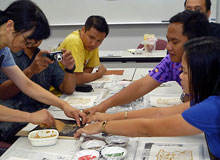 |
Participants concentrating on their work |
Participants carefully dyeing |
A masterpiece is almost complete |
 |
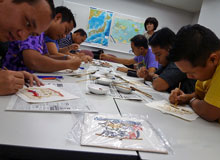 |
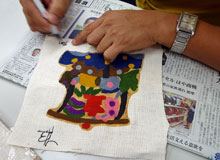 |
Masterpieces are complete |
Participants smiling with their works of art |
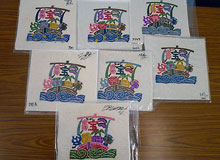 |
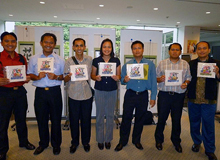 |
October 8, 2011 We took part in 'Saijo Sake Matsuri'
It has become colder, especially in the mornings and evenings, and we were surprised at the change of the season. One day in October, we took part in the Saijo Sake Matsuri (Saijo Sake Festival), which was held near our home, the Hiroshima International Plaza.Saijo, the leading town of Sake (rice wine) in Japan, is located in Higashihiroshima City, where there are many Sake breweries. You can see many storehouses and magnificent chimneys here and there. This ‘Sake Matsuri’ is one of the biggest festivals in Saijo. People who like Sake gather from many parts of Japan every year.
The Hiroshima International Plaza near Saijo also set the mood for this festival in the whole building. The fashion show and dinner party were held as the Sake Festival Eve event. In the fashion show, some of the foreign participants wore the traditional costumes of their own countries. The Philippines participants of AJOC also took part in it.
The neighborhood of Saijo was crowded with many stalls and tourists on the festival day. We were also there to study how to make Sake by visiting some breweries and trying freshly made Sake.
In the afternoon, we paraded the street in Saijo performing ‘Sake midare-bayashi’ (Sake Drumming Music) with the local pupils. This ‘Sake midare-bayashi’ has been a traditional performance in Saijo from ancient times. Every participant had one drum and one stick and paraded around the town with striking their drums.
At first some foreign participants were confused by the peculiar Japanese rhythms, but we completed this parade for after 2 hours with the encouragement of tourists and local people along the street. We could completely master the difficult rhythm at last.
Participants in traditional clothes |
Participants learning about Sake making |
Visiting some Sake breweries |
 |
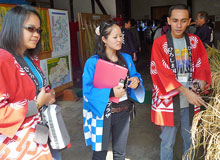 |
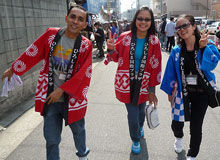 |
Photo with Sake barrels |
Tasting real Sake of Saijo |
Calligraphy after tasting |
 |
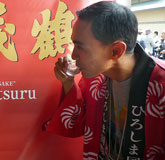 |
 |
Parading along the streets |
Short break during the parade |
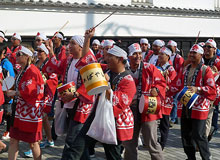 |
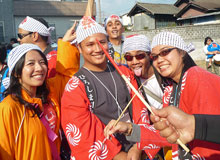 |
November 18, 2011 We made Dorayaki
On November 18, 2011, we were given an opportunity to learn how to cook “dorayaki” by instructors specially invited by the staff of Hiroshima International Plaza.
We all were very excited to learn how to cook this famous and delicious cake. Dorayaki is very well known in our countries. If someone mentions dorayaki, everyone will
remember Doraemon. Doraemon, the Japanese manga and anime character, loves dorayaki. It has been a plot device several times throughout the series. This is a kind of pun,
though his name comes not from "dorayaki" but from the word "doraneko" (stray cat).
Doraemon is a famous Japanese comic series created by Fujiko F. Fujio which later became an anime series and an Asian franchise. The series is about an earless robotic
cat named Doraemon, who travels back in time from the 22nd century to aid a schoolboy, Nobita.
Dorayaki is a type of Japanese confection, a red bean pancake which consists of two small pancake-like patties made from castella wrapped around a filling of sweet red bean
paste. It originally only had one layer, and the current shape was invented in 1914 by the Ueno Usagiya. In Japanese, dora means "gong", and because of the similarity of
the shapes, this is probably the origin of the name of the sweet. Legend has it that the first dorayaki were made when a samurai named Benkei forgot his gong (dora) upon
leaving a farmer’s home where he was hiding and the farmer subsequently used the gong to fry the pancakes, thus they named it dorayaki.
We all tried to cook dorayaki by ourselves while the instructors gave good explanation about the cooking method from the beginning until the end. We enjoyed having a
meal together afterwards. We will never forget this, even after we return to our respective countries. We will try to cook dorayaki again.
“I hope it’s good" |
 |
Everybody took part |
Participants carefully cooking |
Instructors were very kind |
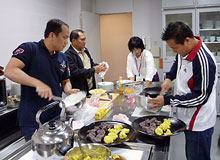 |
 |
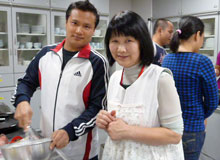 |
December 22, 2011 Japanese tea ceremony
Participants learned the Japanese tea ceremony at Hiroshima International Plaza as part of events that bring them into contact with the Japanese culture.
|
||
 |
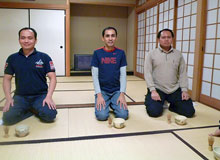 |
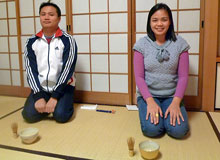 |
January 6, 2012 Flower arrangement (Ikebana)
Participants learned flower arrangement at Hiroshima International Plaza as part of events that bring them into contact with Japanese culture just after they greeted the new year in Japan.
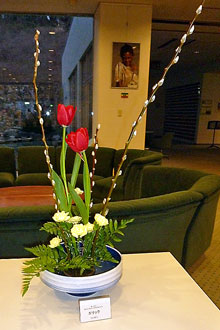 |
 |
 |
 |
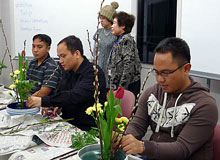 |
 |
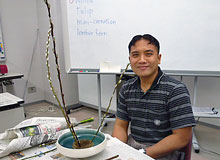 |
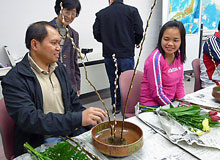 |
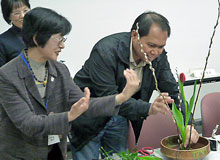 |
 |
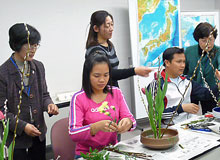 |
 |
 |
January 14, 2012 Tondo and Mochitsuki
AJOC participants and their friends of JICA training course were invited to join the tondo (burning of New Year decorations) and mochitsuki (pounding rice for rice cake) festival by Misonou Elementary School.
That festival was held at the school plyaground near Hiroshima International Plaza in Saijo, Higashihiroshima.
They enjoyed the festival together with students and people from the community and tasted mochi (rice cakes) that they pounded.
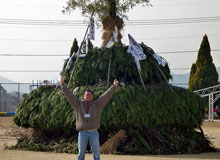 |
 |
 |
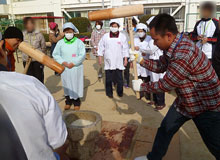 |
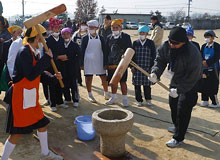 |
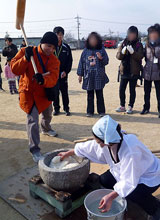 |
 |
January 26, 2012 Japanese Paper Doll making
AJOC participants had an opportunity to experience Japanese culture through paper doll making. They were a good hand at dealing with tiny parts of Japanese paper dolls and made very nice dolls with the help of kind instructors.
They were quite creative by changing the size and shape of a hair ornament and so on. All of them enjoyed and happy about their beautiful paper dolls.
Participant making heartily |
Participant making heartily |
Participant making heartily |
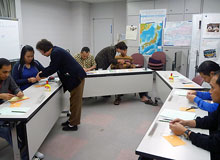 |
 |
 |
Participant making heartily |
Participant making heartily |
Participant making heartily |
 |
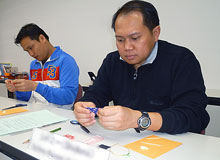 |
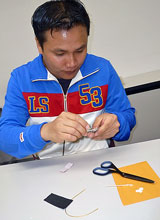 |
A beautiful doll |
With kind instructors |
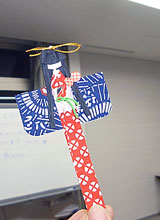 |
 |
February 17, 2012 AJOC participants tried calligraphy and paintings
AJOC participants learned calligraphy and paintings. The subject was Hina matsuri, the Doll Festival (March 3).
At first the instructor gave a brief explanation about one of the Japanese traditional events, Hina matsuri. She talked about its history and custom.
Next participants practiced to draw a design with a brush. They wrote part of “Hina matsuri” song in hiragana they had learned in the Japanese language class. Finally they drew and wrote to complete their art works.
Explanation by the instructor |
Participants practicing |
Participants practicing |
 |
 |
 |
Participants coloring |
Participants coloring |
They were all well done |
 |
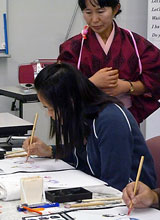 |
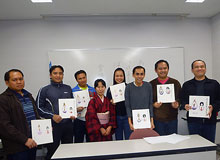 |
March 2, 2012 The certificate of Japanese language class was given
AJOC participants have attended the evening Japanese class for about one year at Hiroshima International Plaza where they stay. All of them have completed the class with excellent results. They were given certificates of completion and gifts from the instructors who helped them a lot. They had the training daytime and they took the night class every Friday. Sometimes they were tired after the training, but they attended for such a long period. The day has come.
On the occasion each of them made a speech to express their impressions about their stay in Japanese.
 |
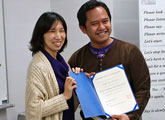 |
 |
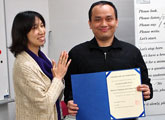 |
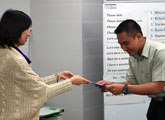 |
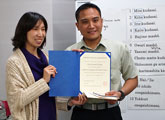 |
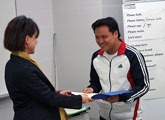 |
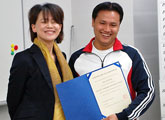 |
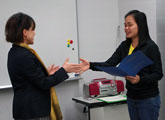 |
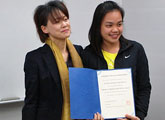 |
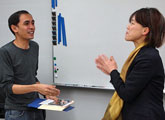 |
 |
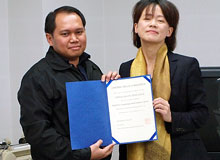 |
 |
| this picture can be enlarged by clicking on it. |














